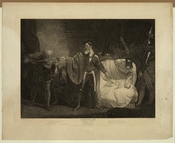The Tragedy Within A Romance
In 1623, the complete works of Shakespeare were published in the First Folio. Within this Folio were the works of Shakespeare categorized by their genre. There were tragedies, histories, comedies, and the final four were romances. Prior to this time, romance was not a widespread genre in anyone's writings. We can see by means of the "genealogy" of writing, that the romance we know today was created through the combination of the Greek novels and Shakespearean comedies. This alliance between the two genres is apparent in Shakespeare's Winter's Tale. The most obvious indication to this suggestion is in the first three acts of the play. Within these acts a whole tragedy can be seen and all it's parts defined to show that this Romance was written by meshing to types of play together.
The first three acts of the Winter's Tale are where the tragedy takes place.
These three acts can be broken down into five acts, as suggested by Bill, the great comparative literian. The first of these five acts is the exposition. The story is set up and you are thrust into Leontes internal passion of jealousy. The second act is where Leontes expresses his passion externally by accusing Hermione of sleeping with Polixenes. He then has his wife taken off to jail. The third act is where we see the first contest, or agon. This takes place when Paulina brings the baby daughter from jail and presents it to Leontes. The two battle back and forth, attempting to prove themselves. The fourth act is the main agon, or the place at which we are at the peak of competition. Hermione stands before the king and the lords and she denies infidelity. However, no matter how convincing she is, Leontes' mind is set as to her actions in the past. The fifth act is the resolution, and this is when the oracle is read. Leontes realizes his jealousy and his errors, and is punished by Apollo, who kills Mamillius and Hermione. This ends the tragedy within the romance. Leontes has lost everything and it sincerely feels tragic.
This suggestion is rather apparent when told the play is a romance and the first three acts are deeply depressing and tragic. With further exploration, this idea of a tragedy, combined with a more comic atmosphere to create a romance, can be even more obvious. However, just this simple explanation of events, is enough to allow a deeper understanding into the works of Shakespeare.


